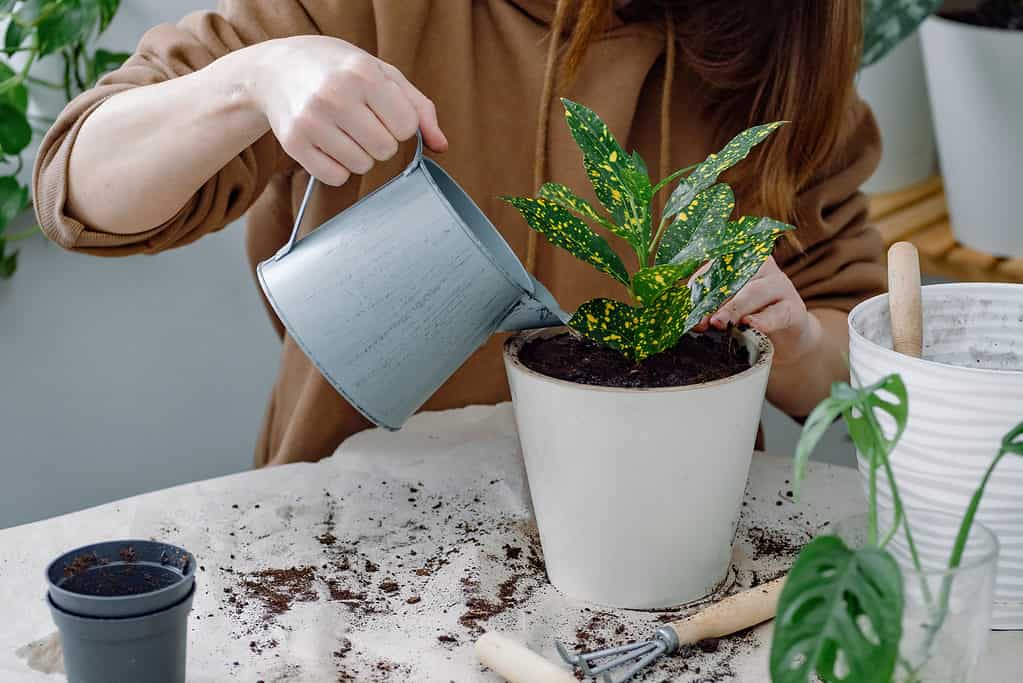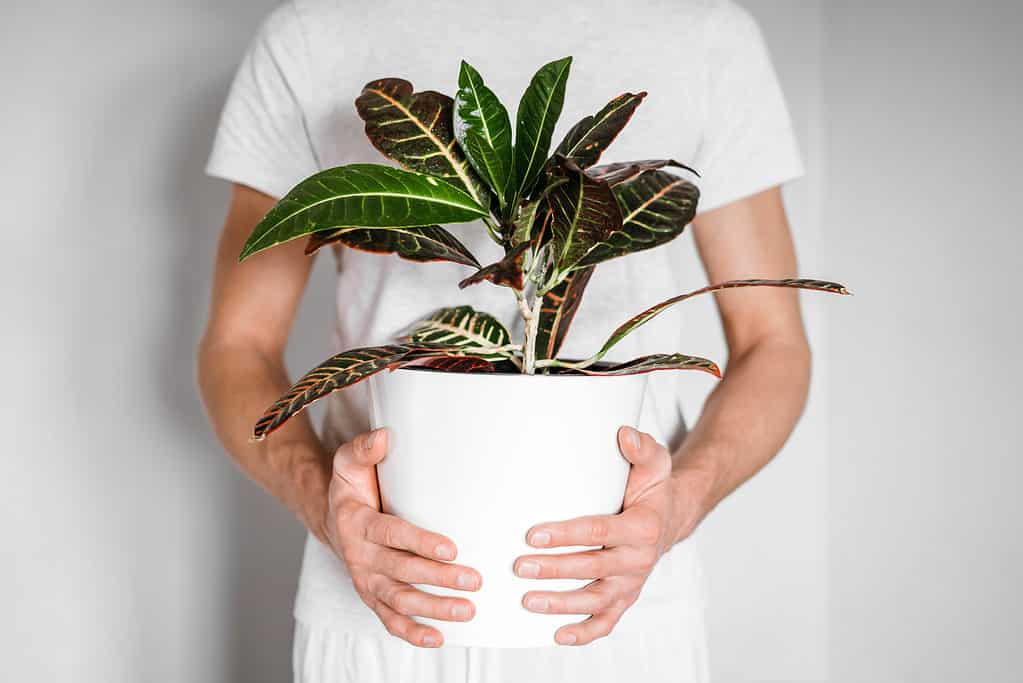The croton plant, also known as Codiaeum variegatum, boasts vibrant, variegated leaves and virtually endless leaf configurations. If are interested in growing a houseplant with many different varieties, croton is the right plant to pick.
Outdoor croton plant growth is most successful in warm, muggy areas. They prefer abundant water and full to dappled light. To reproduce their optimal circumstances, it might be difficult to grow croton plants inside for some people in certain locations. However, if you replicate its native outdoor environment, this plant can be quite easy to grow. The croton is a fantastic indoor plant since it grows much more compactly in pots than it does outdoors, where it may grow to be around eight feet tall. Around one foot is often added to the height of Codiaeum variegatum per growing season.
Keeping the right temperature is the greatest difficulty in caring for croton plants inside. The plant will start shedding leaves if it gets too chilly. That being said, crotons are well worth the effort for the vibrant color explosion they can bring to a room. Other advantages of croton plants include air purification, humidity boosts, and mood and productivity enhancement. Any time of year, provided that the temperature stays consistently between 70 and 80 degrees F indoors, outdoors, or in a greenhouse, is suitable for planting Codiaeum variegatum. Keep in mind that crotons are poisonous to both people and animals, so choose your planting locations carefully.
Interested in knowing even more about growing beautiful crotons indoors? This guide will break down all of the basics you need to know about growing a croton in your home for years to come.
Water Requirements for Indoor Croton Houseplants
Due to the waxy covering on their leaves, croton plants are fairly drought-tolerant, yet it is simple to overwater them. Water thoroughly when the top two inches of soil have dried off. Another indicator that it’s time to water your croton plant is some wilting of new growth at the ends of the stems. Never let plants stand in standing water, which can damage their roots. Watering croton plants may be a delicate science, just like other plants. Watering the croton plant frequently is necessary, but avoid overwatering. While too little water will dry out the humidity-loving plant, too much water can lead to root rot. New croton foliage may be used as a gauge for when it needs water since it will wilt when dehydrated.

Keep an eye on your croton plant’s (pictured) appearance and behavior when developing the right watering schedule.
©iStock.com/Regina Burganova
Fertilizer Requirements for Indoor Croton Houseplants
Use quality indoor plant food a month after planting to provide croton plants with the nourishment they require for optimal development. Apply straight to the soil and water as usual once weekly, as directed on the label. Use one pump for smaller pots under six inches in diameter; for bigger pots, use two pumps. Reduce feedings in the winter, when growth is slower, to once a month.
Pruning an Indoor Croton
Croton plants don’t need to be pruned, but if lower leaves have fallen off and you want to promote new growth, just cut the branches or stems off at the right height, and the plant will quickly fill out. Snip each stem’s developing tips off to promote a bushier plant. Poinsettias include crotons in their family. A sticky, milky fluid seeps from pruning wounds or areas where leaves or petals have fallen off on all members of this family of plants. Always use gloves while trimming these plants since the sap might give some individuals a rash.
Can A Croton Grow Properly Indoors?
Croton plants may be grown indoors in pots, but they should be placed in a spot with a lot of sunshine exposure. The croton’s hues will dwindle without light. In the event of a dry indoor atmosphere, a humidifier could be beneficial for crotons. The plant may easily get dusty when maintained inside. If this occurs, you may take the plant outside to shower it clean or wipe away any dust and bug droppings with a moist sponge.
Can I Put My Indoor Croton Outside?
Croton plants thrive in strong light indoors, but if you merely take them from your front room into the scorching heat outside on the patio, they will suffer from shock. Croton plants must first be “hardened off” in order to be prepared for the relocation if you want to enjoy them outside throughout the summer.
Start by keeping them outside during the day and bringing them inside at night in a protected spot like a porch or patio. Start putting them outside full-time after three or four days. Move them to the preferred outdoor area in full or dappled sunshine a few days later. Croton plants will shed a few leaves as they acclimate to their new environment when you bring them back inside during the fall.

Potted crotons (pictured) do best when kept either only outside or only inside.
©Anastasia Gubinskaya/Shutterstock.com
How to Grow, Plant, and Maintain Crotons Indoors
Remember that your croton will grow upright and ultimately risk becoming top-heavy when selecting a container for it. Choose a container that won’t topple over easily as the croton grows. Alternately, prepare to move to larger pots gradually. Use a potting mix that drains effectively. Crotons like to be kept damp but not submerged.
Croton is a distinctive and vibrant landscaping plant that may be cultivated outside in regions with hot, muggy summers. They perform nicely planted with annuals or in pots with a tropical theme. Croton must be brought indoors when nighttime lows reach about 50 degrees F. As a result, growing them inside is frequently preferable for their general health, even if it might be challenging.
Croton should be placed in a bright area, such as an eastern, southern, or western window. A croton’s younger leaves will be less vibrant if it receives little light. Allow the soil to dry between waterings while keeping it equally wet. If the humidity level in your home or office is low, spray the leaves of your croton once per week with filtered water or put a tray of moist stones next to the plant.
Croton Plant Indoors: Tips
Croton leaves have a tendency to get a bit dusty. To maintain the leaves clean and dust-free, gently wipe them with a wet cloth twice a month. While the plant is actively developing, fertilize it in the spring and summer. Avoid fertilizing more frequently or at all throughout the fall and winter.
Starting new croton plants from four to six-inch stem cuttings is possible. Place the cutting in a glass of water after removing the bottom leaves. Plant in a small container after roots have developed. If the plant has outgrown its current container, repot it in the spring.
Croton plants can have tiny, inconsequential blooms as they mature. The so-called blooms will first emerge as little bulbs that resemble holly berries in size and form and may even have extensions that shoot out like miniature fireworks.
Tips for Growing Crotons Indoors
These plants have a reputation for being picky partly because they frequently give off a negative initial impression. A young Croton plant will frequently lose some or all of its leaves within a few days after being brought home from the store. The new owner is left to wonder, “How did I fail to care for a croton houseplant properly?”
You did not fail; this is typical croton behavior, as they are quite dramatic. Croton plants dislike being moved; when they are, they can quickly experience shock and lose leaves. So it’s important to keep the plant as stationary as possible. Don’t be alarmed by the loss of leaves if you must move the plant (such as when you acquire one). The plant will recover its leaves quickly with the right care, and after that, it will show itself to be a hardy houseplant.
Like many indoor plants, crotons require the right amount of humidity and irrigation to thrive. It does thrive from high humidity because it is a tropical plant, so placing it on a rock tray or spraying it often will make it look its best. Only water cannon plants in pots when the top of the soil seems dry to the touch. Then, water should be applied until the container’s bottom is filled with water. As the plant cannot handle temperatures below 60 degrees F, it should also be kept away from drafts and the cold. The croton will lose leaves and could die if exposed to temperatures below this.
FAQs About Growing Crotons Indoors
A specific kind of croton plant known as Croton michauxii, or Michaux’s croton, is known by the popular name rushfoil. Throughout the genus, all of the several species are sometimes referred to together by the term “croton.”
There are several types of croton plant varieties. Red, orange, purple, pink, yellow, green, and white are just a few of the hues this plant may grow into. The various varieties include the banana croton, the superb croton, the oakleaf croton, and several more.
What Happens if You Consume Croton?
Even if the croton plant is not the most deadly species, you shouldn’t take a chance and consume it. When ingested in high amounts, it can produce nausea, vomiting, diarrhea, and other similar symptoms. The croton plant also releases a sap that can irritate skin and discolor clothing. Cats and humans may both be impacted by the croton plant in a similar way. Croton sap can be harmful to cats if consumed. Because the leaves are large and vibrantly colored, cats may find them to be quite attractive. In the event that you have both a cat and a croton plant, place the plant out of your cat’s reach. Take your cat or other pet to the doctor if you feel they may have consumed any part of a croton plant and they are acting sluggish or vomiting.
The cast iron plant and the poinsettia are distant cousins of croton, which is a member of the Euphorbiaceae plant family. One species of croton, Croton tiglium, has a history of being used medicinally as a purgative. Croton plants are now largely employed for their ornamental qualities. An otherwise green environment is given a splash of color by the addition of a croton plant.
Although common houseplant pests like mealybugs, spider mites, and scale insects can affect crotons, they are often free of pests and diseases.
Crotons are the perfect indoor plant for those who don’t mind the challenge of replicating their native habitat indoors. If you put the effort in, you’ll have a large and beautiful croton that will grow a whopping foot each year. What’s not to love about these big, lovely plants?
Want to learn more about the incredible croton plant? Take a look at our complete guide to everything croton-related!
The photo featured at the top of this post is © aimpol buranet/Shutterstock.com
FAQs (Frequently Asked Questions)
Can croton plants be kept indoors?
Yes. Crotons thrive when planted in containers, as long as they receive adequate light, water, humidity, and temperatures.
Are croton plants difficult to care for indoors?
Croton plants are relatively easy to care for indoors. Simply provide them with bright light, lots of humidity, and a warm place in your home.
Do croton plants do well in big pots?
Crotons do well in big pots, especially once the plant grows quite large and is at risk of tipping over.
Thank you for reading! Have some feedback for us? Contact the AZ Animals editorial team.






